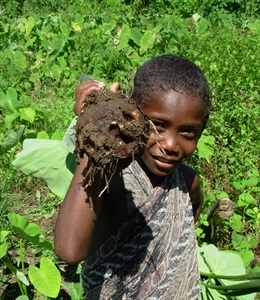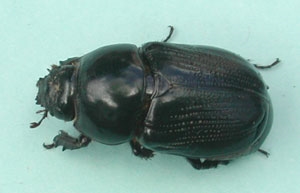Taro beetle, Papuana beetle
Pacific Pests, Pathogens and Weeds - Online edition
Pacific Pests, Pathogens & Weeds
Taro Papuana beetle (030)
Papuana species. There are 18 species in Papua New Guinea, 11 of which damage taro; common species are: Papuana woodlarkiana, Papuana huebneri, Papuana trinodosa, Papuana biroi, Eucopidocaulus tridentipes and Papuana szentivanyi.
Native to Asia (Indonesia) and Melanesia. It is recorded from Fiji, Kiribati, New Caledonia, Papua New Guinea, Solomon Islands, and Vanuatu.
Common hosts of Papuana beetles are seedlings of oil palm and coconut, Alocasia (giant taro), banana, Cryrtosperma (giant swamp taro), sugarcane, Pandanus and taro.
Adult beetles do the damage by burrowing into the underground parts of their hosts (Photos 1&2 ).
The adult is a shiny black beetle, 15-25 mm long (Photo 3). The beetles have horns on the head, but the number and size differs among species. Those of the male are generally larger. Eggs are laid about 7 weeks after the female emerges from the soil. The eggs are laid singly; they are white, oval and 2-3 mm long. Grubs emerge after about 2 weeks. These are white, and C-shaped at rest. They moult three times and when mature are 25-40 mm long. At about 90 days they pupate for 3-4 weeks before the adult emerges. The entire life cycle takes 4-5 months.
Male beetles are less mobile: they colonise the taro corms, awaiting the arrival of females. After mating, the female flies to find a breeding site, usually places with decaying organic matter, e.g., rotten logs/stumps, manure, saw dust, along river banks and in the fibrous roots of grasses. Each female lays up to 300 eggs during a lifespan of about 20 months. The adults are capable of flying up to a kilometre, and they are attracted to lights.
When the forest is disturbed, for instance due to logging or cyclones, Papuana beetles are common in taro gardens. In the forest, ferns (Angiopteris species) are a common host.
Oil palm and coconut seedlings, and taro wilt and die when the tunnels reach the growing point. More commonly, plants remain alive, but grow poorly. Holes bored in the corms of taro make them unfit for market, and where damage is considerable they are not even fit for home use.
Estimates of the amount of damage are hard to come by, but in Papua New Guinea it is put at about 15%, with losses as high as 80% in individual gardens. In many parts of Solomon Islands, taro is very difficult to grow because of Papuana beetles, and they are one of the reasons why farmers have abandoned the crop. This is serious, because loss of taro means a loss of genetic diversity, and this may impact food security. It may also undermine cultural traditions, many of which are dependent on taro.
Look for young oil palm, coconut and taro that are wilting. Pull up to check if Papuana beetles are present. Use light traps to catch the beetles, and sample potential breeding sites for the grubs (compost heaps, sawdust, rotting logs) and wild hosts, such as grasses (Paspalum species and Brachiaria mutica), bananas ferns and sugarcane.
NATURAL ENEMIES
Several natural enemies have been recorded, including the fungus Metarhizium, a tachinid fly and the cane toad, but none are considered effective in controlling populations sufficiently well to stop corm damage.
BIOLOGICAL CONTROL
Although much work has been done using the fungus Metarhizium anisopliae, and it has been shown to work under experimental conditions, there is no recommendation as yet for farmers. It is difficult for farmers to maintain stocks of the fungus, which has to be grown on rice grains and applied to each planting hole, as well as likely breeding sites.
The virus that infects Oryctes rhinoceros, the dynastid beetle of coconuts, has been tried against Papuana, but without success.
CULTURAL CONTROL
Several cultural control measures have been suggested, including crop rotation, clean planting material (i.e., free from soil and beetles), and destruction of breeding sites near gardens, but these are impractical, and are unlikely to be effective, even if farmers tried to implement them.
Recently, there has been interest in the use of cover crops. There is evidence that planting taro into a mulch formed by a legume cover crop keeps taro relatively free from Papuana beetles. Whether this is a physical barrier, or some other reason is not known. The legume Mucuna is the cover crop with greatest potential as it grows vigorously, and is an annual. But Pueraria phaseoloides and other ground legumes may be just as effective.
CHEMICAL CONTROL
Use imidacloprid (sold under the trade name of Confidor), or cypermethrin a pyrethroid (Mustang); both are effective in controlling Papuana beetles in Fiji, and in trials in Solomon Islands. To control Papuana beetle, 125 mL of a 1.5 mL/L solution of imidacloprid is applied to the planting hole at planting and at 3 months.
In the island of Nendo, Temotu Province, Solomon Islands, it is reported that farmers are using Confidor, but instead of putting the insecticide in the planting hole they are putting the 'tops' in Confidor for an as yet unknown time before planting .
____________________
When using a pesticide, always wear protective clothing and follow the instructions on the product label, such as dosage, timing of application, and pre-harvest interval. Recommendations will vary with the crop and system of cultivation. Expert advice on the most appropriate pesticide to use should always be sought from local agricultural authorities.
AUTHORS Helen Tsatsia & Grahame Jackson
Information from Carmichael A, et al. (2008) TaroPest: an illustrated guide to pests and diseases of taro in the South Pacific. ACIAR Monograph No. 132, 76 pp. (https://lrd.spc.int/about-lrd/lrd-project-partners/taropest); and Carmichael A. (2005) Taro beetle (Papuana woodlarkiana). PaDIL - http://www.padil.gov.au; and from CABI (2019) Papuana huebneri (taro beetle). Invasive Species Compendium. (https://www.cabi.org/isc/datasheet/38792). Photo 2 Graham Teakle, Canberra. Photo 3 Sada N Lala Taro beetle management in Papua New Guinea and Fiji. Secretariat of the Pacific Community.
Produced with support from the Australian Centre for International Agricultural Research under project PC/2010/090: Strengthening integrated crop management research in the Pacific Islands in support of sustainable intensification of high-value crop production, implemented by the University of Queensland and the Secretariat of the Pacific Community.






